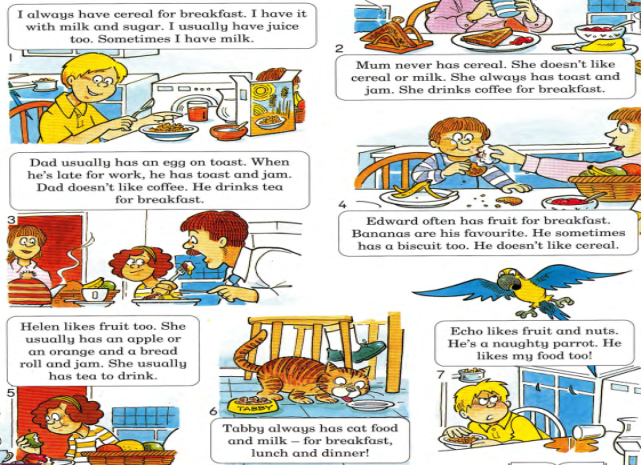Відкритий урок з англійської мови у 4 класі на тему: "Їжа".
Презентаційний урок з англійської мови у 4 класі
Тема: Їжа.
Цілепокладання: громадська відповідальність: ефективно взаємодіяти разом у сім’ї, групі, команді; розуміти потребу працювати разом; здоров’я та безпека: впорядкувати власний робочий день, тиждень із дотриманням здорового способу життя; обговорювати вибір продуктів, корисних для здоров’я; наводити приклади купівлі продуктів для здорового способу харчування; ціннісна-смислова компетентність: самовизначення учня в ситуаціях навчальної й іншої діяльності; здатність бачити й розуміти навколишній світ; загальнокультурна компетентність: особливості культури харчування; особливості володіння ефективними способами розпорядку та часу прийому їжі; комунікативна компетентність: взаємодія з оточуючими й окремими людьми та подіями; навички роботи у групі; відігравання різних соціальних ролей у колективі; особистісне вдосконалення: духовний, фізичний й інтелектуальний розвиток учня; саморегуляція та самопідтримка; культура мислення та поведінки.
Тип уроку: закріплення знань, умінь та навичок учнів.
Обладнання: дошка, зошит, проектор, комп’ютер, смарт-дошка, роздатковий матеріал.
Хід уроку
- Підготовка до сприйняття іншомовного мовлення.
- Привітання.
Teacher: Greetings. Stand up, please. I’m very happy to see you here today. Good morning children.
Children: Good morning teacher.
Teacher: Say good morning to our dear guests.
Children: Good morning dear guests.
- Мотивація навчальної діяльності.
Teacher: Dear pupils, are you ready to get know why do we need to know what to eat and why? How to stay healthy all the time? How to keep fit? We have two groups: Explorers and quick minds and we’ll see who’s quicker and smarter. I wish good luck to both of you.
Children: Yeah.
Teacher: Let’s do this.
Children: Let’s do this. (Clap your hand).
- Оголошення теми уроку, цілей.
Teacher: Dear children today our topic is food and we are going to repeat everything what we’ve learnt before. We need to consider and repeat the words about food, practice our reading and speaking skills, listen, write and understand why do we need to remember food rules.
- Перевірка домашнього завдання.
Teacher: But first of all I would like to start your food presentation. You had to make a plan what kind of food do you like and eat everyday. Who wants to be the first?
Children: (Answering one by one).
Teacher: Great. Thanks a lot. You made a good job.
- Warming up.
Teacher: Now, we are going to practice next sounds which you see on the screen. (Picture 3)
[æ] [e] [iː] [ɪ]
Jam Bread Sweet Mineral
Salad Egg Cream Fish
Hamburger Lemonade Cheese Milk
Sandwich Breakfast Tea Chicken
Teacher: Good job.
- Vocabulary revision.
Teacher: Now, tell me please what kind of food do you see on the screen? Look and say. (Pupils say what they see). (Picture 4 “What is it?”).
Teacher: What is it?
Children: It is honey.
Teacher: What is it?
Children: It is salad.
Teacher: What is it?
Children: It is a hamburger.
Teacher: What is it?
Children: It is a sandwich.
Teacher: What is it?
Children: It is a fish.
Teacher: What is it?
Children: It is a chicken.
Teacher: What is it?
Children: It is a cheese.
Teacher: What is it?
Children: It is bread.
Teacher: What is it?
Children: It is an egg.
Teacher: What is it?
Children: It is a banana.
Teacher: What is it?
Children: It is sweets.
Teacher: Well done.
- Healthy and unhealthy food.
Teacher: Pupils, look at the blackboard, you see the words “healthy” and “unhealthy” food, you need to choose the word and stick it in the right column. Let’s do this one by one. (Pupils come to the blackboard to stick the words).
Healthy Unhealthy
Honey Hamburger
Salad Chicken
Sandwich Sweets
Fish
Cheese
Teacher: Great job children.
- What do you eat?
Teacher: Let’s consider the next task. You have 3 meals: breakfast, lunch, dinner. Your main task is to get know what do we eat on each meal. Try to guess then answer. Goo luck. (Picture 15).
Teacher: Well done.
- Pupils, I would like to propose you watch the video about what will happened if you eat healthy and unhealthy food. Be attentive and make a conclusion.
(The video is running).
- Основна частина.
- Reading.
Teacher: You worked well enough. I would like you to pay an attention on the picture on the screen here, but first you must read four texts and drag the food in the correct place. (Pupils read the text and drag the pictures in a right place).
-
Physical exercises.
Teacher: What about move the body? I hope you enjoy it.
Children: Yeah, we like it.
(The video has begun).
Teacher: Perfect. Sit down, please.
- Listening.
Teacher: I propose for you to listen to the text and then in groups find and stick the parts of the text on the sheet of paper, but before we start listen it, we have to repeat some adverbs which will be there.
(Picture 18). (Children read the adverbs after the teacher).
Children: Usually, often, never, sometimes, always.
Teacher: Good work, so prepare for listening, it will be twice, then you have to make this text correct and we would be able to check if everything is right.

(Pupils are reading the text).
Teacher: Unbelievable. You did it again. Congratulations.
- Заключна частина.
- Marks.
Teacher: Today we worked great, I’m really satisfied of you, I want to give marks which you deserved for this lesson. I think you really achieve it, we repeated with you everything what we’ve already known.
- Homework.
Teacher: Now, write down the homework for the next lesson, what do people need to stay healthy and why? (Picture 19).
Teacher: Stand up children. The lesson is over. You are free and see you next time. Good bye.
Children: Good bye teacher, good bye dear guests. (Pupils are going out).

про публікацію авторської розробки
Додати розробку
